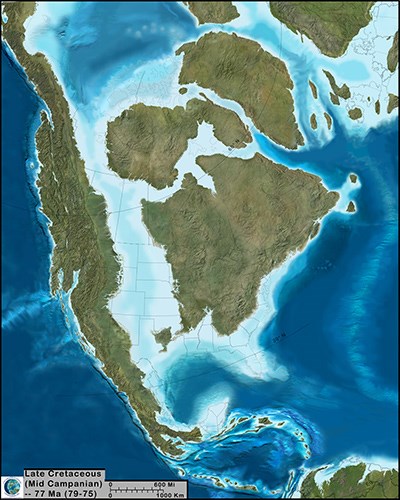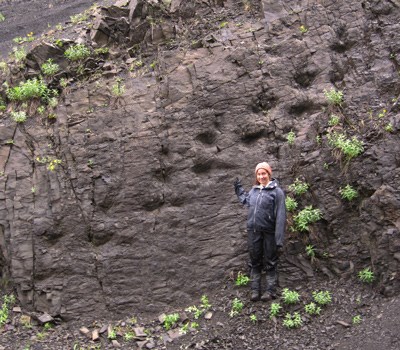
Unsplash photo / Abigail Keenan 
Map used with permission from Colorado Plateau Geosystems, Inc. Where were we? During the Cretaceous, Denali was located slightly to the north of its present location with a paleolatitude of 65 – 70 degrees north. Today, Denali is located at 63 degrees north.
Soil and drainage conditions varied within the floodplain, including frequent inundation as illustrated in the mural. Better-drained and more built-up areas hosted mixed forest of flowering shrubs and deciduous conifer trees, while low-lying, marshy areas were dominated by cycads and horsetails. Floodplain
At the base of the mountains and alluvial fans was a gently sloping floodplain that was drained by a major river system that flowed from west to east. In between the rivers and streams, lakes, ponds, and marshes formed. This wet landscape provided excellent habitat for life to flourish and, fortunately for us, created an ideal environment for preserving plant fossils and ancient footprints. 
NPS Photo All of the dinosaur fossils found in Denali to date have been found in the Cantwell Formation. Around 80 million years ago during the Late Cretaceous, crumpling of the crust due to tectonic compression created a basin to the north of the ancient east-west mountain range that has since been replaced by the Alaska Range. Over the next 10 million years, nearly 4,000 meters of sand, gravel, and silt filled in this basin and became bedrock. We now refer to this sedimentary rock as the Cantwell Formation. Dinosaurs may have lived in Denali prior to the Late Cretaceous, but there are no rock formations present in the park from periods such as the Jurassic that are of the appropriate composition to have preserved fossils. Fun fact
Mountain ranges have risen and eroded away many times in Alaskan history. Prior to the current Alaska Range, there was an older mountain range that filled the skyline 70 million years ago. Just like today’s mountains, snow and rain fell on the peaks and eventually flowed downstream, washing some of the rocks and dirt away with it. At the base of the mountains, large piles of this sediment collected and formed gently sloping, triangular-shaped alluvial fans. |
Last updated: August 18, 2016
